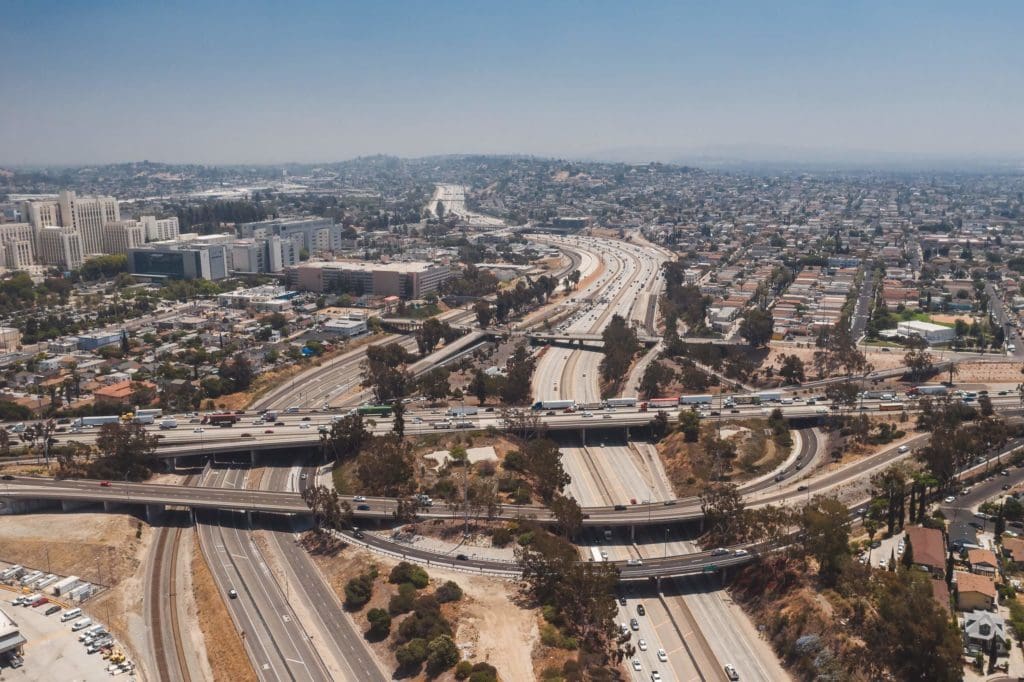A large step forward for safety, but what’s with the climate analysis?

Last week, the US Department of Transportation announced the first recipients of both its Safe Streets and Roads for All (SS4A) and MEGA grant, two new programs in the Bipartisan Infrastructure Law. The SS4A selections were great and affirmed this USDOT’s commitment to protecting the lives of pedestrians and bike riders. The MEGA grants, on the other hand, were a mixed bag. Especially alarming, several of the awards made the extraordinary claim that widening highways would reduce pollution and climate emissions! Let’s dig in.
Safety First
With the announcement of the SS4A winners last Wednesday, more than half of all Americans now live in a city or county with a funded Safe Streets action plan. The $5 billion, five-year SS4A program was established to help communities across the country end traffic violence on their roads. The first round of grants ($800 million) went to 510 communities across the United States. USDOT awarded 473 grants for Safe Streets action plans and 37 grants to build infrastructure that keeps pedestrians and bike riders safe.
Implementation grants made up 60% of the total funding. Larger cities were the primary recipients, perhaps unsurprisingly, since many have dedicated staff working on road safety. Emphasis in these awards is on keeping people outside of cars safe; 80 percent of the implementation dollars explicitly benefit bicyclists, 90 percent walkers.
The volume and geographic spread of communities receiving funding for Safe Streets action plans speaks to national demand to stem the number of injuries and deaths on our roads. The awards went to a wide variety of communities that skewed smaller and more suburban and rural than their implementation grant counterparts. It will still take sustained momentum and pressure to build the projects developed in these plans, but the wide distribution of action plans has the power to seed future rounds of SS4A implementation grants and spread funding beyond larger cities.
The Good MEGA Grants
Pedestrian safety is the priority for one of the MEGA grant recipients. The Roosevelt Boulevard Multimodal Project in Philadelphia received $78 million as one of nine MEGA grants, which are intended to fund projects “too large or complex for traditional funding programs”. Roosevelt Boulevard is a deadly 12-lane arterial that runs through several Philadelphia neighborhoods. Between 2012 and 2021, a horrifying total of 119 people have been killed on this street, 49 of whom were pedestrians.
The MEGA grant project reconfigures the boulevard by adding infrastructure for walking, biking, and transit, to satisfy the objectives of keeping everyone on the street safe, improving multimodal and transit access for disadvantaged neighborhoods, and reducing air pollution from vehicle traffic. The award sends a signal to other communities to think big and apply for future MEGA grants to tame their dangerous-by-design arterials.
Other notable MEGA grant projects include several major transit projects: $292 million for a rail tunnel underneath the Hudson River in New York City, a $117 million commuter rail project in Chicago, and $30 million in bus improvements and multimodal investments in Santa Cruz.
An Out-of-Touch Climate and Pollution Analysis
Three of the MEGA grant projects celebrate the false claim that adding travel lanes will reduce congestion, which according to this rationale ultimately reduces vehicle emissions because fewer vehicles are idling. But this approach fails to take into account the well-established phenomenon of induced demand, which entices even more drivers onto the expanded road and more than offsets the gains from reducing congestion.
We know from independent research that the number of vehicles is much more important than congestion in determining emissions. Wider roads lead to more vehicle miles traveled and thus more emissions (you can do the math yourself for highway expansions in your state with RMI’s Shift Calculator).
Even from a common sense perspective, it’s clear that the math doesn’t add up. For instance, the I-10 Calcasieu River Bridge Replacement Project in Lake Charles, LA plans to expand I-10 so nearly 20,000 more vehicles can cross it each day (a 25% increase from current traffic). But somehow, the project claims it will remove 1.6 million tons of greenhouse gas emissions.
Even worse, USDOT repeats the Louisiana Department of Transportation and Development’s claim that air quality will worsen for residents around the bridge without the project. In enshrining state DOT greenwashing claims, USDOT has set a dangerous precedent that stands against the climate goals the Biden administration says it supports.
Secretary Buttigieg’s DOT unquestionably cares more about safety, health and the environment than ever before. We applaud the Secretary’s vocal leadership on increasing pedestrian safety. We could use some of that refreshing honesty and plain speaking when it comes to highway expansion. Highway expansion does not reduce pollution or climate emissions, and USDOT should stop saying so.